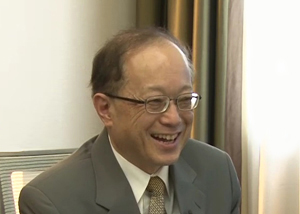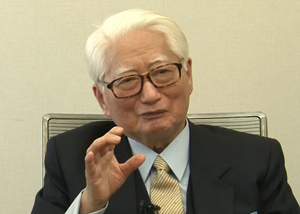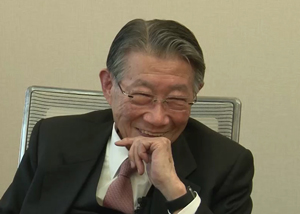| Celebrating the 20th anniversary of Child Research Net (CRN), we hosted a round table talk to discuss the developments of child research over the past years and look towards a new future. The participating members consisted of Dr. Yoichi Sakakihara, the current director of CRN, Dr. Noboru Kobayashi, the founder and honorary director of CRN, and Dr. Takemochi Ishii, a special advisor to and supporter of CRN since its foundation. It was the 1980s, when Dr. Kobayashi propounded "Child Science." It was the time when the high-growth period of the Japanese economy supported by heavy industry came to an end, when people began to seek a new society more in harmony with nature and to enjoy a more well-balanced mode of living. In the first part of this session, we asked Dr. Kobayashi and Dr. Ishii to review and discuss the era of the turning point to this century. They were once the members of the Policy Research Council, a private advisory body supervised by the then Prime Minister Ohira, and provided advice on subjects well beyond their specializations from the standpoint of academia. |
| | 1-1 | 1-2 | 2-1 | 2-2 | |
[Participants]
Yoichi Sakakihara
Director of Child Research Net (CRN); Vice President of Ochanomizu University; Pediatric Doctor. He studied pediatrics under the supervision of Dr. Noboru Kobayashi at the Department of Pediatrics, The University of Tokyo.
Noboru Kobayashi
Honorary Director of CRN; Professor Emeritus of The University of Tokyo; President Emeritus of the National Children's Hospital
Takemochi Ishii
Professor Emeritus of The University of Tokyo; Ph.D. in Engineering. He studied at the Faculty of Medicine at the same time as Dr. Noboru Kobayashi.
[Moderator]
Makoto Kinoshita
Freelance Writer; CRN External Researcher; Secretary-general of the Japanese Society of Child Science supported by CRN
Learning liberty from the USA
Dr. Sakakihara: I am Sakakihara, currently serving as the Director of CRN. Dr. Kobayashi was working as Professor at the department of pediatrics, the University of Tokyo when I joined him there, being many years his junior.
At that time when I joined the department, there were a number of intimidating professors in the Faculty of Medicine, who made me feel the scholarly air of German medical studies. So when I attended a lecture by Dr. Kobayashi, who had just came back from the USA, I felt there was a new atmosphere of freedom, like a clear blue sky. His class probably reflected the approach of medical studies in the USA at that time, which made me feel, "This is where I belong!" and decided to join the department of pediatrics.
At that time, Dr. Kobayashi had a wide sphere of interest going beyond pediatrics studies into various fields such as children as a whole, ecological science, human studies, etc. This may be partly because Dr. Kobayashi had a friend like Dr. Ishii, who had a wide range of interests in engineering and other fields ranging beyond his specialized area of medical studies. I believe that Dr. Kobayashi and Dr. Ishii acquired a broad and liberal perspective on various areas apart from their specializations by inspiring with each other. In today's session, we will ask them to tell us about their thoughts and experiences over the years.

Dr. Sakakihara
Moderator: First of all, I would like to ask Dr. Kobayashi to tell us your story about the time you were working as an intern in the USA after graduating from the Faculty of Medicine, the University of Tokyo in 1954.
Dr. Kobayashi: The Japanese internship system was introduced in the same year I graduated from the University of Tokyo. However, the system only allowed interns to observe medical practices, unlike the American internship system that allowed interns to participate in clinical settings in order to learn. It can be said now that the Japanese intern system at that time could be likened to an empty shell without practical functions.
For this reason, 40 students out of about 130 of the same class year volunteered, saying "Why don't we do our internship in the USA?" In the end, however, it was only two of us, Royal Household Doctor Tatsuo Ikenaga, a surgeon serving the Royal family, and I who went to the USA. None of the others went, due to various reasons such as the difficulty in getting back into the medical department after the internship, although they had all said they wanted to go.
Dr. Ishii: I heard for the first time that only two out of the forty applicants went to the USA. At that time, not many people were motivated like Dr. Kobayashi to learn new things from outside of Japan.
Moderator: Why did it have to be the USA?
Dr. Kobayashi: I was eager to see what the USA was like; a country that had defeated Japan militarily, since I had been at the Naval Academy during the period of hostilities. In addition, I wanted to know how medical education was carried out in the USA. The medical education system after graduation was thoroughly designed in the country, so interns were able to learn proper medical practice at hospital.
Moderator: You wrote in your autobiographical essay "Koby's Note" (Tokyo Igakusha) published last year that you learned two important things when you were studying overseas. One is to study various areas other than medical science by reading a wide range of science journals such as "Nature" and "Science." Another is to have students share opinions freely with each other. Did you intend to leverage your experiences for your next move after you came back to Japan?
Dr. Kobayashi: Of course, I did. But it was difficult to do so in Japan, and I couldn't do it.
Dr. Sakakihara: No, I think you did do it. In the Department of Pediatrics, the University of Tokyo, we used to have a session called a "Chart Round" twice a week. In this session, we made individual oral presentations in front of a professor and shared opinions among colleagues. In the sessions with Dr. Kobayashi, we freely exchanged opinions saying, "Don't you think that...?" and I believed that was how a chart round was supposed to be. But one day, I asked a friend pediatrician from another university about our chart round. He said "No, that is not a chart round. In a chart round, only when a professor asks 'What is this?' can the doctor in charge speak to him, formally explaining 'This is ....' You do not share opinions freely in a chart round." I was very surprised by his answer. I used to express my opinion freely in front of Dr. Kobayashi, even when I was a resident physician, speaking impertinently, saying things like "Dr. Kobayashi, I think this is ..." I thought that free atmosphere Dr. Kobayashi gave us was based on his experiences gained in the USA.
Dr. Kobayashi: I may have been influenced by my experiences in the USA, but largely because of my desire to learn new things after hearing the stories of other researchers, such as Dr. Goodall who specialized in studies of chimpanzees.

Dr. Kobayashi
Dr. Sakakihara: I used to attend clinical lectures and found that Dr. Kobayashi's lectures were completely different from those of other professors. Other professors prepared for the curriculum of child pathology and conducted their lectures based strictly on such preparation. In contrast, the lectures of Dr. Kobayashi went beyond the boundaries of child science, inviting researchers such as Dr. Goodall, a well-known researcher of chimpanzees, and Dr. Gajdusek, a Nobel Prize winner for his research into slow virus infection. It was maybe because Dr. Kobayashi did it naturally, but his classes were unique indeed. After giving an introductory talk, he would then beamingly listen to the guest's talk, saying gently aloud "This is quite interesting, isn't it?"
Study of mother-infant interaction using medical and engineering approaches
Moderator: Having such a liberal view, I think Dr. Kobayashi may have been partly influenced by Dr. Ishii. You once belonged to the Faculty of Medicine, and later moved to the Faculty of Engineering. Why did you do so, Dr. Ishii?
Dr. Ishii: I have been asked this question thousands of times (laugh). When we talk about medical science, we are actually talking about the science of clinical medicine. However, with respect to child health, hygiene issues are most important. Many children will die due to a poor hygiene environment. Infectious diseases and nutrition issues were extremely serious in Japan in the post-war period. Therefore, we had to give due priority to the improvement of hygiene conditions, that is, the standard of living, during the postwar reconstruction.
Our generation did not go to the war front but could well have been involved in suicide attack missions; therefore, we truly knew for ourselves the gap in science and technologies between Japan and the USA. When the war ended, we were all in a state of shock, standing in front of burnt-out ruins in our cities.
Given such a historical backdrop, I was very interested in biological aspects of human beings, and at the same time, physics and engineering relating to science and technologies. I decided to try all of them, and tried medical science at the first onset. Dr. Kobayashi mentioned earlier that the world of medical science in Japan was a long way behind than that in the USA, but the same could have been said for the industrial world. For example, I investigated the medical equipment situation with the Medical Instruments Association after I started studying engineering, and also found out that Japan was lagging far behind western countries in the field of medical equipment. This, of course, hampered academic achievement. In order to improve medical engineering such as today's medical electronics, I believed that it was necessary to develop machine tools or so-called mother machines, which were needed to build up other machinery and equipment, to a point equivalent to the level of western countries.

Dr. Ishii
Moderator: I have read your book "Holonic Path" (Kodansha). In this book, you wrote that your interest continued in biological systems or bio modeling even after you started studying engineering. Did you have the idea of "Mother-Infant Interaction" in your mind at that time?
Dr. Ishii: My research on the entrainment process in mother-infant interaction conducted jointly with Dr. Kobayashi was a typical "medical engineering approach." It was the first experience for me to enter into the field of psychophysics such as a mother-infant relationship. Based on the idea of Dr. Kobayashi, we output the numerical values of synchronization between movements and the mothers' verbal contacts through an image processing system.
Dr. Kobayashi: When we launched the studies on babies at Aiiku Hospital, Dr. Ishii and his team joined us to support the setup. When we summarized the vast amount of data to publish in a pediatrics journal, we came to a striking conclusion. That is, mothers move in response to the motion of their babies.
Dr. Ishii: We measured the energy level of a mother when talking to the baby, and calculated the energy curve and the movement of the baby's hand. As a result, a significant correlation coefficient was obtained, which was still within our range of expectations.
However, the data also revealed the fact that mothers were talking to their infants in response to their motion, as well as babies moving in response to the mothers' verbal contacts. Therefore, we obtained two correlation coefficients, which we found to be very interesting.
Dr. Sakakihara: It can be said that the behavior of the mother and her baby is comparable to a duet of dancers, which could not be identified just through observation.
Dr. Ishii: Yes, the mother and baby synchronize with each other.
Dr. Sakakihara: In other words, the babies not only responded to their mothers, but the mothers also moved in response to their babies.
Dr. Ishii: We produced numerical values by analyzing data, which cannot be obtained by observation only. This can be the ultimate evidence to justify our research.
Moderator: Hearing it even now, this finding is innovative and very interesting. Consequently, Dr. Kobayashi proposed the study of child science in the early 1980s based on such research. (To be continued in 1-2)
| | 1-1 | 1-2 | 2-1 | 2-2 | |














